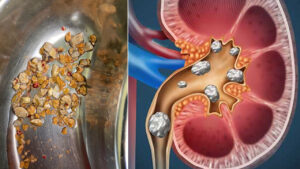Kidney stone
 A kidney stone is a solid item that is created from urine-based compounds. Kidney stones can be made of calcium oxalate, uric acid, struvite, or cysteine. Shockwave lithotripsy, stereoscopy, percutaneous nephrolithomy, or nephrolithotripsy are all options for treating kidney stones. Severe lower back pain, blood in the urine, nausea, vomiting, a fever, chills, and bad-smelling or murky urine are all common symptoms.
A kidney stone is a solid item that is created from urine-based compounds. Kidney stones can be made of calcium oxalate, uric acid, struvite, or cysteine. Shockwave lithotripsy, stereoscopy, percutaneous nephrolithomy, or nephrolithotripsy are all options for treating kidney stones. Severe lower back pain, blood in the urine, nausea, vomiting, a fever, chills, and bad-smelling or murky urine are all common symptoms.
Diverse wastes are dissolved in urine. Crystals start to develop when there is too much waste in too little liquid. The crystals draw in additional substances and combine to produce a solid that will only grow unless it is eliminated from the body through urination. Typically, these substances are removed in the urine by the kidney, the body’s chief chemist. Most people’s kidney stones are either washed out by adequate liquid or prevented from developing by other substances in urine. The substances that cause stones to develop are phosphate, calcium, oxalate, cysteine, urate, and xanthine. A kidney stone is a solid item that is created from urine-based compounds. There are four different kinds of kidney stones: calcium oxalate, struvite, and uric acid.
Symptoms
Some kidney stones are the size of a sand grain. Some are the size of a stone. A number of them are the size of golf balls! Generally speaking, the symptoms become more pronounced the larger the stone.
The symptoms could be one or more of the following:
- severe pain on either side of your lower back
- more vague pain or stomach ache that doesn’t go away
- blood in the urine
- nausea or vomiting
- fever and chills
- urine that smells bad or looks cloudy
When a kidney stone irritates or blocks the urinary tract, pain develops. Extreme pain is quickly intensified by this. Kidney stones typically move through the body without harm, but generally not without excruciating pain.
Causes
Possible contributing factors include inadequate hydration, excessive or insufficient activity, obesity, weight loss surgery, and a diet high in salt or sugar. For certain people, family history and infections may be significant. Consuming excessive amounts of fructose is associated with a higher risk of kidney stone formation. High fructose corn syrup and table sugar both include fructose.
Prevention
Getting adequate liquids will keep the concentration of waste materials in your urine from building up. If you are fully hydrated, your urine should be very light yellow to transparent since darker pee is more concentrated. Your primary fluid intake should be water. The average person needs to consume more than 12 glasses of water each day. Consult a healthcare practitioner to determine how much water is appropriate for you. Compared to soda, sports drinks and coffee/tea, water is healthier. You should drink extra if you exercise or if it’s hot outside. Small amounts of sugar and high-fructose corn syrup should be used.
Consume more fruits and vegetables to reduce the acidity of the urine. Stones may be less likely to develop when the urine is less acidic. Animal protein results in more acidic urine, which elevates your risk of kidney stones.
If you are overweight, you should endeavor to lose weight. Crash diets and high-protein weight-loss plans that contain a lot of animal protein, however, can increase the risk of stone development. You require enough protein, but it must be consumed as part of a healthy diet. When beginning a weight loss program or other dietary interventions to lower the risk of kidney stones, seek advice from a trained dietitian. Don’t be perplexed by your “calcium” stone. Dairy products contain calcium, but because calcium binds with oxalate before it enters the kidneys, they actually help avoid stones. Those who consume the least calcium through their diet are more likely to develop kidney stones. A stone may develop from potassium, sodium, and protein byproducts. A calcium oxalate stone is the most typical kind of kidney stone. The majority of kidney stones are created when oxalate, a byproduct of several diets, binds to calcium while the kidneys are producing urine. Oxalate and calcium levels are higher because the body is dehydrated and over salted.
